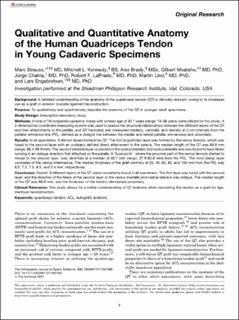Qualitative and quantitative anatomy of the human quadriceps tendon in young cadaveric specimens
Strauss, Marc Jacob; Kennedy, Mitchell L.; Brady, Alex W.; Moatshe, Gilbert; Chahla, Jorge; LaPrade, Robert F.; Lind, Martin; Engebretsen, Lars
Peer reviewed, Journal article
Published version
Permanent lenke
https://hdl.handle.net/11250/2986638Utgivelsesdato
2021Metadata
Vis full innførselSamlinger
- Artikler / Articles [2119]
- Publikasjoner fra Cristin [1107]
Originalversjon
Orthopaedic Journal of Sports Medicine. 2021, 9(9), Artikkel 23259671211037305. 10.1177/23259671211037305Sammendrag
Background: A detailed understanding of the anatomy of the quadriceps tendon (QT) is clinically relevant, owing to its increased use as a graft in anterior cruciate ligament reconstruction.
Purpose: To qualitatively and quantitatively describe the anatomy of the QT in younger adult specimens.
Study Design: Descriptive laboratory study.
Methods: A total of 18 nonpaired cadaveric knees with a mean age of 30.1 years (range, 18-38 years) were utilized for this study. A 3-dimensional coordinate measuring system was used to assess the structural relationships between the different layers of the QT and their attachments to the patella, and QT thickness was measured medially, centrally, and laterally at 2-cm intervals from the patellar eminence line (PEL; defined as a straight line between the medial and lateral patellar eminences) and proximally.
Results: In all specimens, 3 distinct layers formed the QT. The first (superficial) layer was formed by the rectus femoris, which was fused to the second layer with an unclearly defined direct attachment to the patella. The median length of the QT was 86.9 mm (range, 68.4-98.9 mm). The second (middle) layer consisted of the vastus medialis and vastus lateralis and was found to have fibers running in an oblique direction that attached on the patella. A “fuse point,” where the proximal part of the rectus femoris started to merge to the second layer, was identified at a median of 48.7 mm (range, 27.9-62.6 mm) from the PEL. The third (deep) layer consisted of the vastus intermedius. The median thickness of the graft centrally at 20, 40, 60, 80, and 100 mm from the PEL was 8.5, 7.2, 7.5, 6.5, and 5.4 mm, respectively.
Conclusion: Overall, 3 different layers of the QT were consistently found in all specimens. The first layer was fused with the second layer, and the direction of the fibers of the second layer or the vastus medialis and vastus lateralis was oblique. The median length of the QT was 86.9 mm, and the thickness of the tendon diminished proximally.
Clinical Relevance: This study allows for a better understanding of QT anatomy when harvesting the tendon as a graft for ligamentous reconstruction.
Beskrivelse
This article is distributed under the terms of the Creative Commons Attribution-NonCommercial-NoDerivs 4.0 License (https://creativecommons.org/licenses/by-nc-nd/4.0/) which permits non-commercial use, reproduction and distribution of the work as published without adaptation or alteration, without further permission provided the original work is attributed as specified on the SAGE and Open Access pages (https://us.sagepub.com/en-us/nam/open-access-at-sage).
